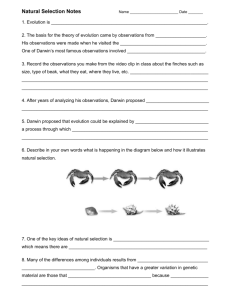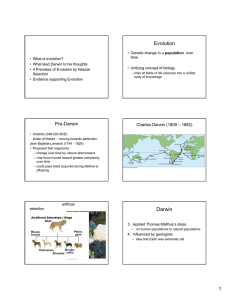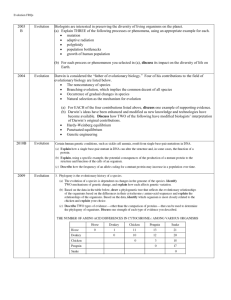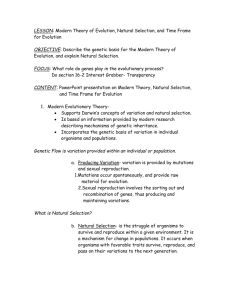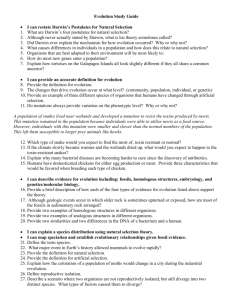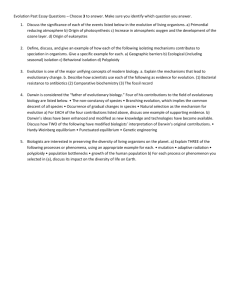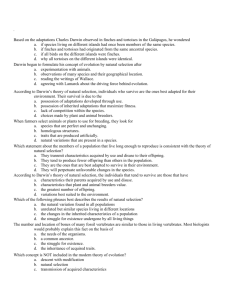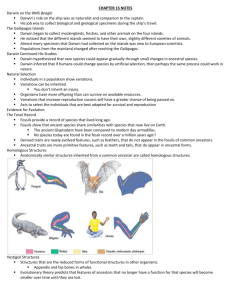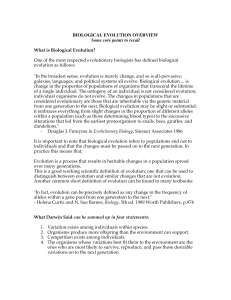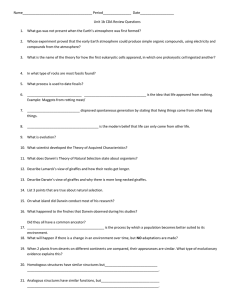Objectives Evolution 5/30/2012
advertisement
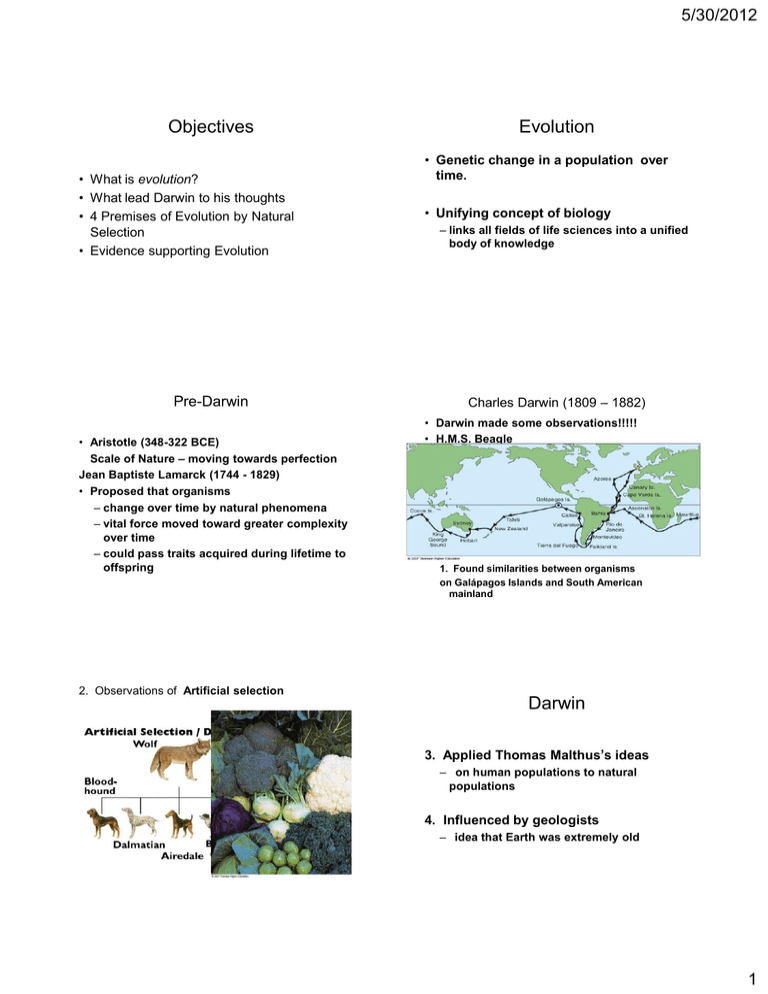
5/30/2012 Objectives • What is evolution? • What lead Darwin to his thoughts • 4 Premises of Evolution by Natural Selection • Evidence supporting Evolution Pre-Darwin • Aristotle (348-322 BCE) Scale of Nature – moving towards perfection Jean Baptiste Lamarck (1744 - 1829) • Proposed that organisms – change over time by natural phenomena – vital force moved toward greater complexity over time – could pass traits acquired during lifetime to offspring 2. Observations of Artificial selection Evolution • Genetic change in a population over time. • Unifying concept of biology – links all fields of life sciences into a unified body of knowledge Charles Darwin (1809 – 1882) • Darwin made some observations!!!!! • H.M.S. Beagle – Based on observations: 1. Found similarities between organisms on Galápagos Islands and South American mainland Darwin 3. Applied Thomas Malthus’s ideas – on human populations to natural populations 4. Influenced by geologists – idea that Earth was extremely old 1 5/30/2012 4 Premises of Evolution by Natural Selection resulting from Darwin’s observations 4 Postulates of Evolution by Natural Selection 1. Variation exists among individuals in populations. (and the variation is heritable) 3. In a population not all individuals survive to reproductive age i.e., There are limits on population growth! Organisms compete with one another for resources: food, living space, water, light Predators, disease, weather Thus, not all individuals survive to reproduce 2. Variation that exists in population is heritable 4 Postulates of Evolution by Natural Selection 4. Differential reproductive success Offspring with most favorable characteristics likely to survive and reproduce pass favorable characteristics to next gen. • Leads to accumulation of favorable traits in the population over generations Important points to remember: 1. Differential reproduction 2. Evolution occurs in populations not individuals (but the environment selects traits at the individual level). 3. Mutation is important (provides genetic variation - synthetic theory of evolution) 4. Don’t’ think of evolutionary change as purposeful - Panda’s thumb Natural Selection • Results in adaptations – evolutionary modifications from environmental pressure – improve chances of survival and reproductive success in a particular environment • Over time – accumulated changes in geographically separated populations can produce new species Modern Synthesis • Or synthetic theory of evolution – combines Darwin’s theory of evolution by natural selection with modern genetics - incorporates our understanding of genetics/DNA • Explains: – why individuals in a population vary (genetic variation in a population) – how species adapt to their environment 2 5/30/2012 Evidence for Evolution?? • Fossils Fossil Record • Sedimentary rock – layers occur in sequence of deposition • Unicellular deeper than multicellular – - simpler towards more complex – - fossils show series of changes in many organsims • Radioisotopes – in rock accurately measure rock’s age Transitional fossils: Homologous Features: Similar features in different species. Natural selection modified for a particular Strongly suggests a common ancestorin a •function. Features derived from the same structure common ancestor E.g., Whale Evolution Homologous Features in Plants Analogous Structures Structural features that have similar functions that evolved independently – i.e. they are not homologous structures!!!!! Result in convergent evolution – organisms with separate ancestries develop similar adaptations in response to similar selective pressures (environments) 3 5/30/2012 Analogous Features Fig. 18-12a, p. 402 Vestigial Structures • Nonfunctional/degenerate structures were present and functional in ancestors organisms Evidence provided by Developmental Biology • We note that gene mutations can affect events in development (snakes hind limbs) Development in different animals controlled by same kinds of genes indicates shared evolutionary history Continental Drift Biogeography: Past and present distribution of organisms • Geographic distribution of organisms – affects evolution (remember the environment selects traits) • Isolated land masses – contain organisms that evolved in isolation – unique to those areas •At one time, continents were joined to form a supercontinent •Continental drift caused landmasses to separate played major role in evolution 4 5/30/2012 Cynognathus Lystrosaurus (a) (b) Molecular evidence for evolution Africa India Universal nature of genetic code South America Australia Only 4 nucleotides!!!!!!! Antarctica 3 billion pairs in humans Human - chimp 95% same (c) DNA Mesosaurus Glossopteris (d) Fig. 18-16, p. 405 Genetic Changes Genetic evidence • Accumulation of genetic changes Species A – since organisms diverged Species B Species C Amino acid sequences on proteins (cytochrome c) Cetaceans (whale, dolphin) Hippopotamus Ruminants (cow, sheep, giraffe) Pig Camel Artiodactyls • Can evolutionary hypotheses be tested experimentally? Common ancestor of hippos and whales Hypothesis : based on DNA sequences Who is more closely related to who. Common ancestor of artiodactyls and cetaceans Fig. 18-17, p. 407 5 5/30/2012 6
